Baxter portrait in progress - start to finish
- Kevin Roeckl
- Oct 14, 2023
- 6 min read
September 1
I started a new portrait of Baxter, who is 12 years old. Some interesting facts about Baxter:
❤️ His dad Brian has a “Surgery Center“ in the garage to stitch up Baxter’s ravaged/mutilated stuffed toys.
❤️ When Brian wanted to adopt Baxter from a shelter, the woman who was his wife at the time didn’t want Baxter because in his adoption photo she thought he had a white bandage on his paw. “Something‘s wrong with him”, she declared.
❤️ Baxter’s favorite toy is a “Fruit Poops“ toy, a gift from family friends Scott Brunton and Duke Wolf who became famous for their dog-poop calendars “Monthly Doos” published for 10 years, with many spin-off products like chocolate "Doo Drops" and line of "Poop Squeaks" dog chew-toys.
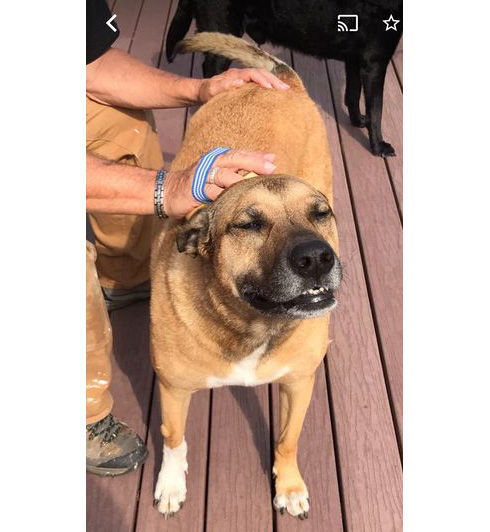
To start Baxter’s portrait I made an underpainting of tan for Baxter’s coat and muted purple for the blanket. Here are the steps:
1
The underpainting on Baxter. I studied many photos of Baxter to understand the basic color of his gold coat. Not too yellow, not too red, not too dark, not too bright and “brassy”. Then did this underpainting with watercolor to “tint” the Canson paper, giving me the right color to work on. All the detail of Baxter will be done with colored pencils over this base color.

I’m working on a beautiful Canson paper called “Moonstone”. It’s a pale grey paper with a hint of magenta to it, and a hint of beige, with little flecks and fibers in it. Here’s a closeup of the paper, with a few pencil lines across it.
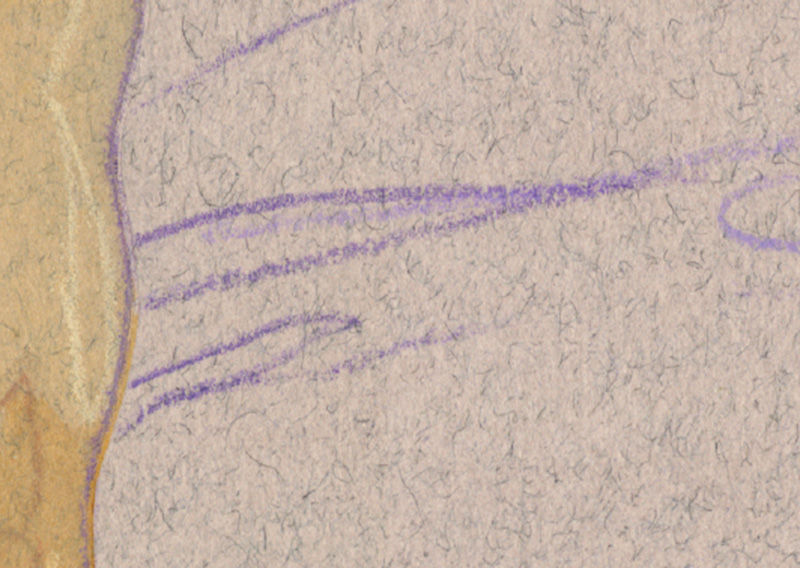
2
After the tan paint dried, I masked off the figure of Baxter with adhesive masking film cut out with an x-acto knife. That protected the crisp edges of the figure so I could make broad sweeping strokes for the purple blanket. First I mixed up a muted purple watercolor. I started at the top with the watercolor thinned with water to make it fairly transparent (lighter) and worked downwards with paint not thinned as much (darker).
While the lighter paint was still wet, I stroked darker purple into it to suggest folds of the blanket. Watercolor artists call that “wet into wet” because the paint bleeds and spreads, giving it soft edges. You can see that effect to the left of Baxter’s rib-cage. Letting watercolor spread into wet paper like that can create unpredictable shapes. Like what the paint did near Baxter’s paws.
After the purple was dry, I peeled off the masking film protecting the figure of Baxter. Now I have nice base colors to work on to do the details of dog and blanket with colored pencil.
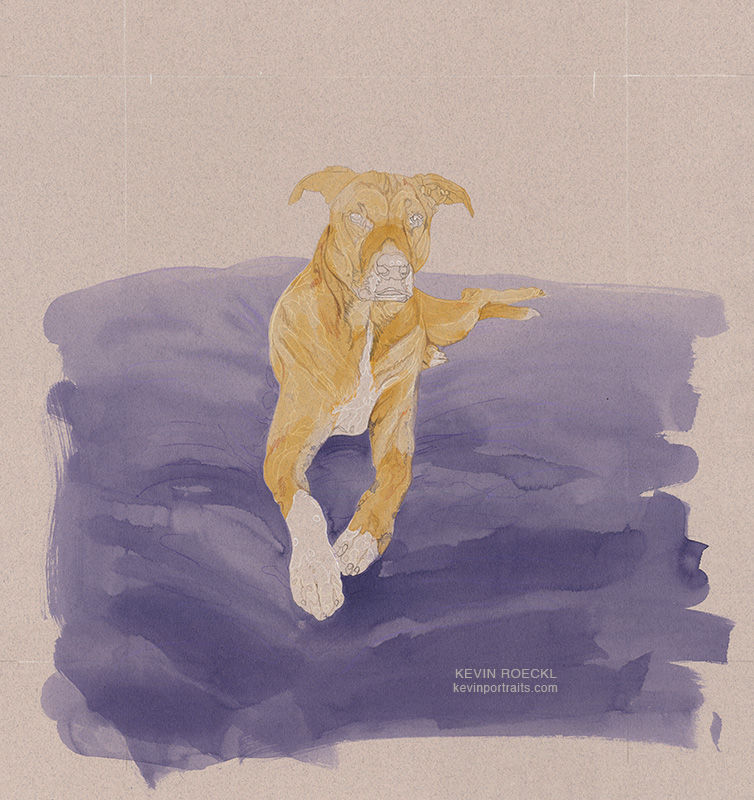
When the portrait is finished it will be cropped like this, you won’t see the sloppy edges of the purple underpainting.
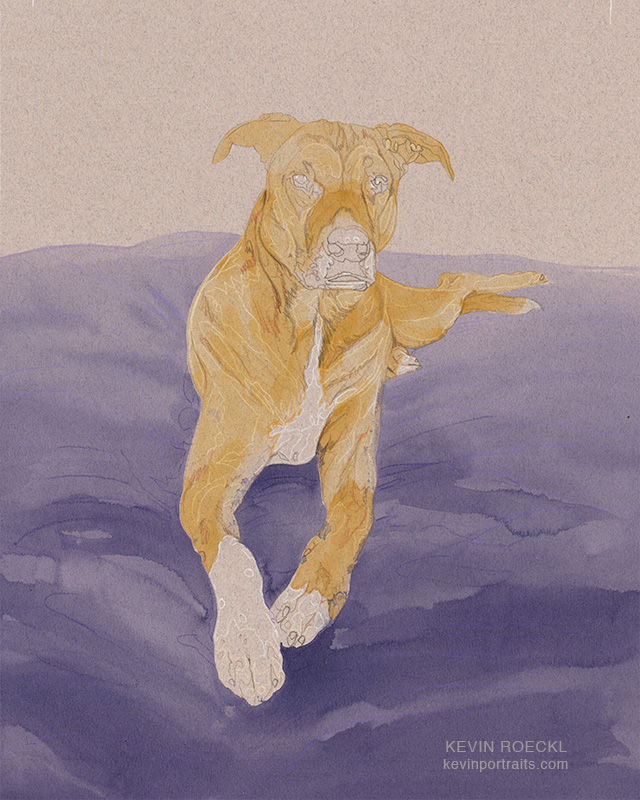
There are only two colors on this portrait so far. Two colors of paint used for the underpainting: tan, and purple. It looks like more because of the darker and lighter shades of those two colors.
Even with only two colors you can already get a good sense of how the finished portrait will look.
I really like this gold and purple color combination.
Baxter portrait in progress 2
The gold underpainting for Baxter’s coat and purple underpainting for the blanket were done (see previous post), then I pressed the artwork for 48 hours under weights to take out the buckles and ripples in the paper caused by the watercolor. Today I started on Baxter’s ears with colored pencil.
In this close-up you can see the beautiful texture of the “moonstone” Canson paper with it’s visible fibers. The Canson company in France has been making papers for over 500 years!
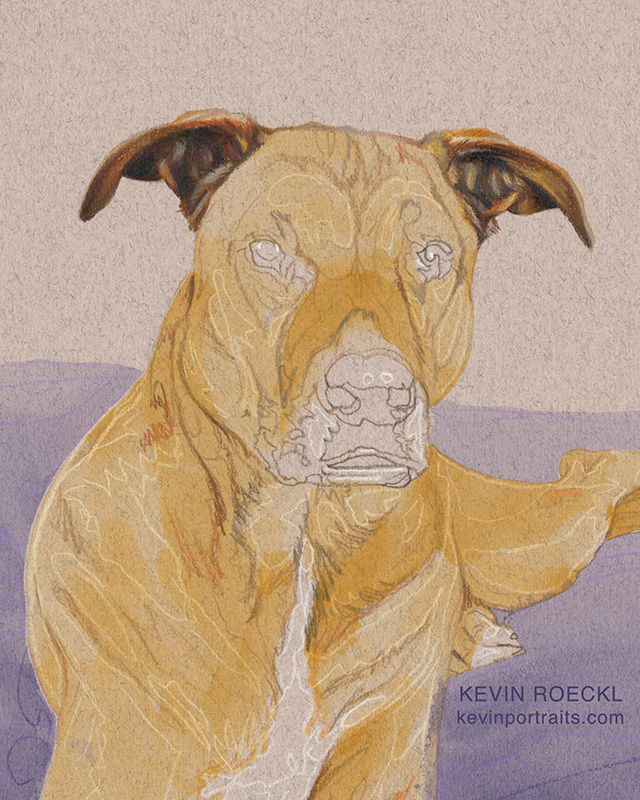
Baxter portrait in progress 3
Now you can see the difference colored pencil makes on the underpainting. It makes a flat image 3-dimensional.
Baxter’s head done with Prismacolor pencil detail over tan and purple watercolor underpainting.
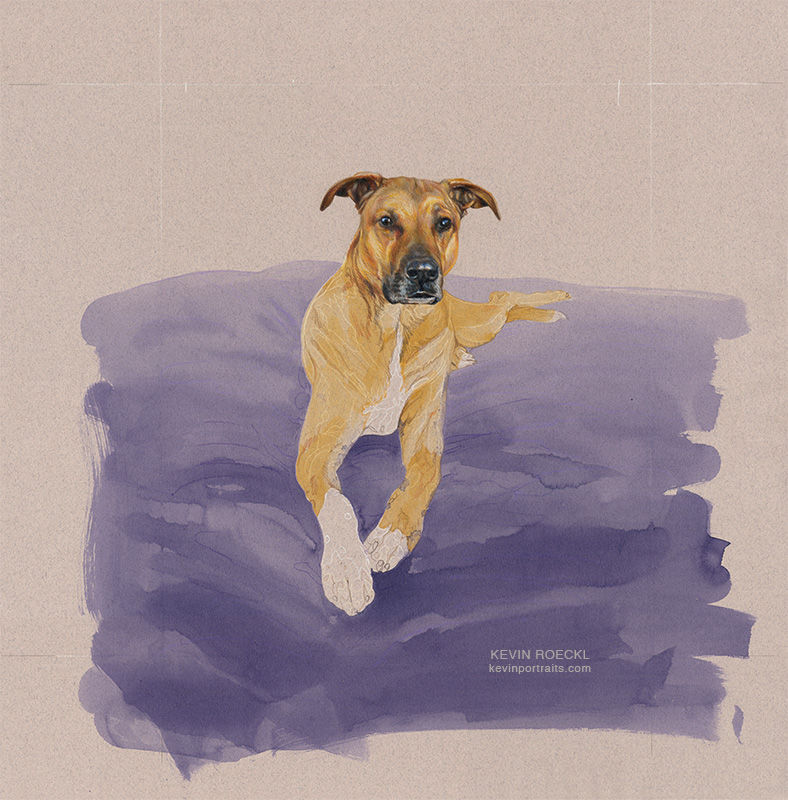
Baxter portrait in progress 4
Baxter has all kinds of interesting colors in his coat.

Baxter portrait in progress 5
Here are the swatches I made to guide me on how the different colors look on this “moonstone” paper.
I studied many of Brian and Frank’s photos of Baxter to understand the color of his coat.
It’s not exactly yellow, and it’s not exactly red,
it’s not blonde, nor is it rust.
It’s golden, the color of dry grass in summer.
Frank took a couple shots of Baxter laying on their dry lawn this summer and pointed that out. And parts of his coat have grey and brown — like the dark “mask” on his forehead. So that required many shades of light and dark mushroom-brown (brownish grey) shading into golds and golden browns, with touches of mauve-grey, as well as blue-grey in a few shadowed places. So many interesting colors in Baxter’s coat!

I'm working on Baxter’s body adding colored pencil detail. That’s still just the underpainting on the right foreleg.
Baxter portrait in progress 6
Baxter’s golden coat finished. Tomorrow I’ll do his white front paws.
It’s funny, this is on “moonstone” paper, which is a pinkish grey — the color behind his head, and showing through on his paws…but with those darker colors around them, his paws look white, don’t they?
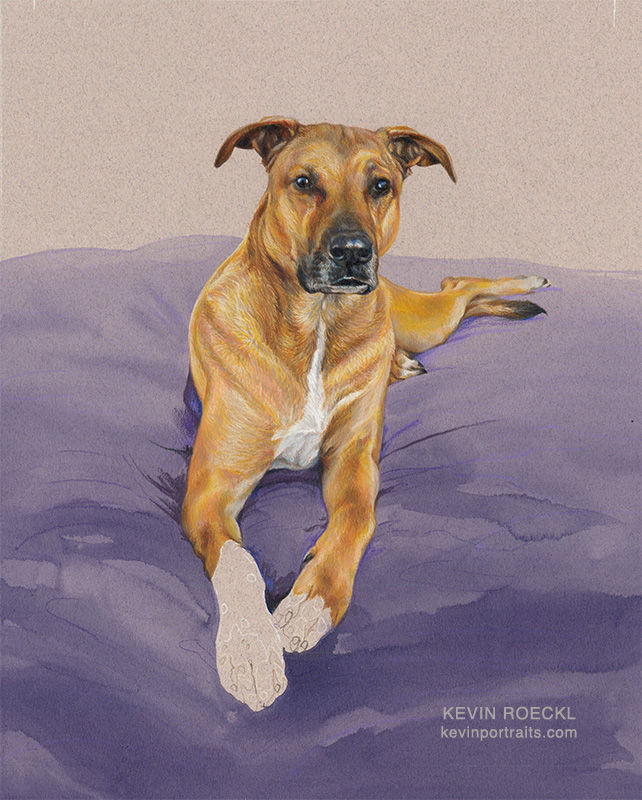
This is how my studio set-up looked after I finished Baxter’s head and started working my way down his body from the neck a few days ago. His front paws look "white" in this pic too. But you can see by the paper color against my white table-top that paper is definitely not white.
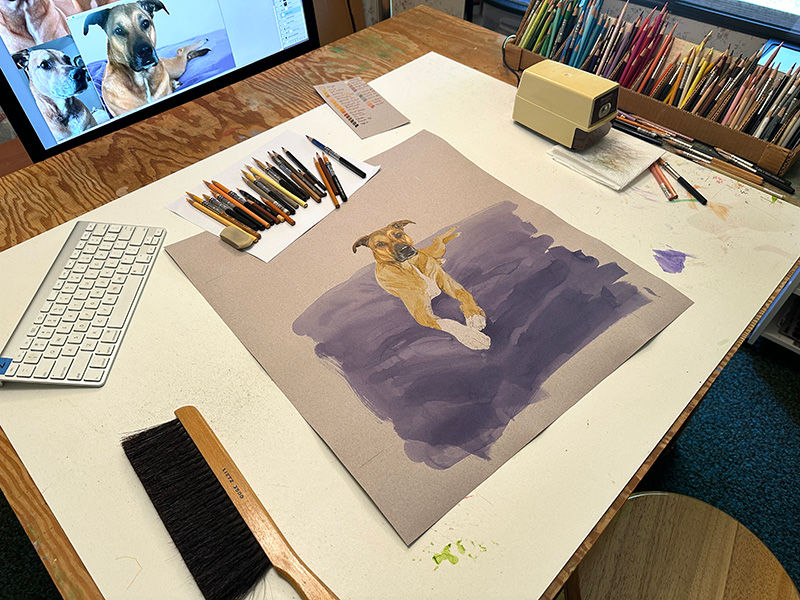
Baxter portrait in progress 7
Working on Baxter’s white paws.
The white paper covering the artwork is to protect the artwork while I’m working. Prismacolor pencil is wax-based, it’s not chalky like pastels. So it doesn’t really mess up the image if you rub your finger across it. But over a period of days rubbing the side of my hand across it hundreds of times while I’m working, would smear the pigment little by little. And could leave a bit of skin oils too. That Canson paper picks up skin oil like a blotter, even when you think your hands are clean. For that reason I wash my hands with soap a jillion times a day. I think that’s a reason I almost never get sick. Thanks to colored pencils.

Baxter portrait in progress 8
finished Baxter’s white paws today.
In the reference photo I was using I saw what looked like two brown spots on the top of Baxter’s paw. I copied that, thinking those were some of the tan and grey spots that he has on his white paws. But in the other photos of Baxter that Frank and Brian sent, I didn’t see those brown spots. So I sent this pic to them, asking if that was something unusual on Baxter’s paw in that photo. Frank replied “It looks like that may have been dirt or food or some thing”.

Baxter portrait in progress 9
Frank and Brian requested an 11 x 14 inch portrait. I always work on larger paper, and trim at the end. Usually I offer clients the option of keeping it larger, at no extra cost. I sent this jpg to Frank and Brian, showing the options. I can leave it at the full size, showing the “raw” edges of the purple watercolor underpainting, or crop it to 11 x 14 (the bold rectangle) or slightly larger to include more of the blankets (thin rectangle). I also sent them jpgs showing how each of the versions would look cropped.

There’s also another decision I asked them to make. The blankets are still just the purple underpainting, with a few pencil strokes of dark purple next to Baxter's front legs. I was planning to add more pencil strokes to put more detail in the blankets, mostly dark purple to indicate the shadowed folds of blanket. But I recommended the blankets be left just as they are. The purple underpainting suggests the folds of the blanket but looks artistic and beautiful because of the way the watercolor spread in the wet-in-wet technique, with soft edges. It’s clear that those are blankets, and they look very soft. I don't want to change that by adding a bunch of spidery purple pencil strokes. I think the artwork is finished just as it is.
Do you agree?
Baxter portrait finished!
I finished the portrait of Baxter for Brian C. and Frank A.
While I was working on it Frank sent this cute story about Baxter:
“I thought I’d let you know about something Baxter does that really connects the two of us. I was sitting with him one day on the couch, and he looked at me so intently. I grabbed his face in my hands, very closely, and stared into his eyes. We were locked. I “flicked” my tongue out and back in quickly. He repeated it. I did it again. He copied. I “flicked” twice. He mimicked me. I repeated, one, then two, and mixed it up and he never missed a beat. It ends by me giving him a big comfort hug and telling him how special he is to us. Our family and friends are always surprised at this connection. He is so smart.”

Watercolor and colored pencil on “moonstone” Canson paper
11 x 14 inches

Comments